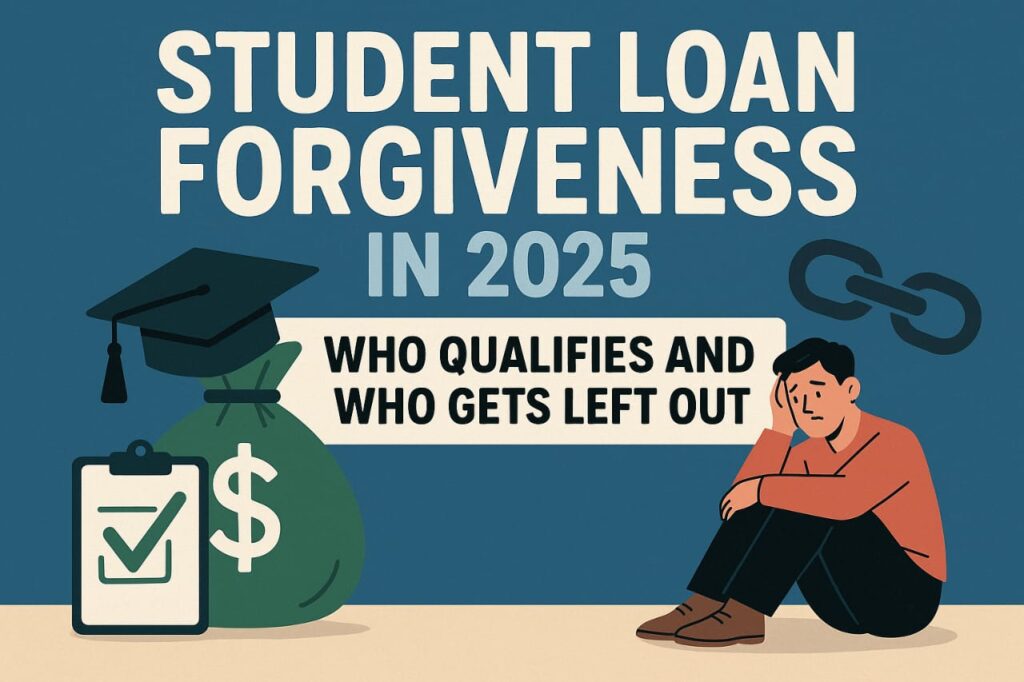
Introduction: Loan Forgiveness in 2025—Hope or Confusion?
In 2025, many Americans are still waiting for help with their student loans. Some programmes help thousands of borrowers, but others are changing or cancelling. This has left many people asking: “Do I qualify for student loan forgiveness in 2025?” And, as significant: “Who gets left out?”
This guide breaks it down in simple terms so you know where you stand.
What is student loan forgiveness?
Student loan forgiveness is when the government wipes out part or all of your student loan debt. It usually happens if you:
- Work in public service or teaching.
- Have a low income and use income-driven repayment (IDR).
- Were part of a forgiveness plan like PSLF or SAVE.
- Had loans from a school that closed or scammed students.
In 2025, some forgiveness programmes remain active. But others are fading or changing due to court rulings and political battles.
Who qualifies for student loan forgiveness in 2025?
You may qualify if you meet one or more of these conditions:
Public Service Loan Forgiveness (PSLF)
Work full-time for the government or a nonprofit for 10 years. If you make 120 payments, the lender can forgive the rest of your loan.
SAVE Plan, which was previously known as REPAYE.
If you’re on the SAVE income-based plan, you might qualify for forgiveness in 10 to 20 years. This depends on your loan type and balance. Some low-income borrowers are seeing parts of their debt forgiven early.
Teacher Loan Forgiveness
Teachers in low-income schools may get up to £17,500 forgiven after 5 years.
Borrower Defense
If your school lied, cheated you, or closed down, you can get help from the borrower defence programme.
IDR Change (One-Time Fix)
Some borrowers now get credit for old payments that didn’t count before. This could help them achieve forgiveness sooner.
H2: Who Gets Left Out in 2025?
Unfortunately, not everyone qualifies. Someone may leave you out if:
Your loans are private.
Private student loans are not covered by federal forgiveness programmes. You will need to communicate with your lender in a direct manner.
You didn’t apply for the right programme.
Some people lose benefits. This happens when they do not join their loans or choose the right repayment plan.
You do not work in public service.
PSLF only applies to non-profit or government jobs. If you work in the private sector, you might not qualify—even if you make payments for years.
You’re in default or behind on payments.
Falling behind on your loan can delay or block forgiveness. It’s important to stay current—or apply for programmes that can help you get back on track.
H2: What Can You Do If You Don’t Qualify?
If you do not qualify right now, you still have options:
- Enroll in an income-driven repayment plan (IDR) to lower payments.
- Join federal loans into one that qualifies.
- Watch for updates—laws and rules keep changing.
- Call your loan servicer to check if you qualify for anything new.
- Ask your employer if they offer student loan help or repayment support.
Conclusion: Forgiveness is real—but it’s not for everyone.
In 2025, student loan forgiveness is aiding many individuals. Yet, it isn’t a universal fix for everyone. Whether you qualify depends on your loan type, your job, and the plan you’re in.
Who qualifies? Federal loan borrowers in public service, those on IDR plans, or victims of school fraud. Who gets left out? People with private loans, wrong repayment plans, or jobs that don’t meet the rules.
If you’re unsure about your status, log in at StudentAid.gov to check. You can also speak with a loan expert for help.